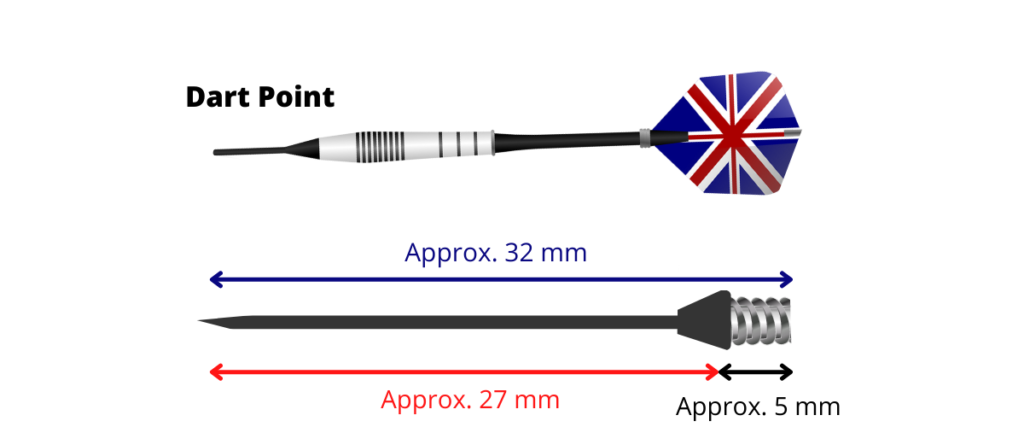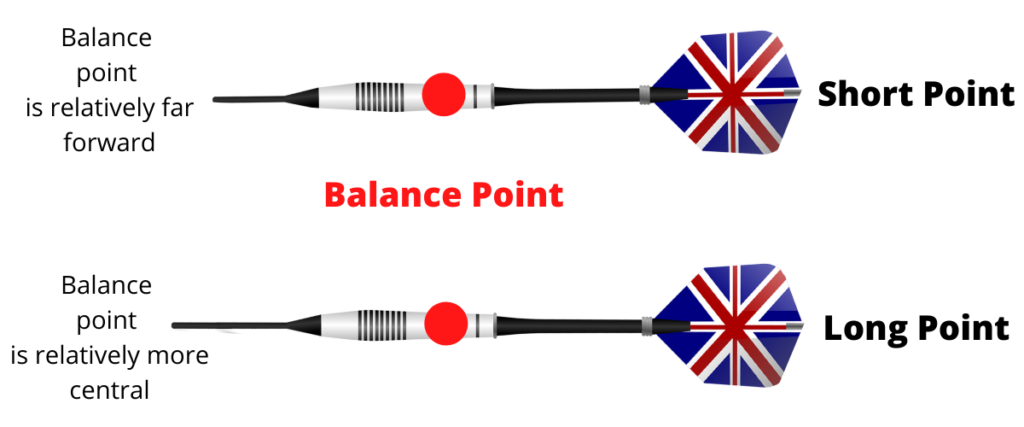Choosing the right dart point (tip) length is important because it can affect several aspects of your game. In this article, I’ll compare long and short dart tips and discuss the average length so you can decide which to choose.
Average Dart Point Length
Dart points vary in length from roughly 25 mm (0.98″) to 50 mm (1.97″). Most professional players use a dart point with a length of 28-35mm (1.10-1.38″). Approximately 5 mm (0.20″) of the total length is inserted into the barrel and the rest of the tip is exposed.
How is Dart Point Length Measured?
Dart point length is measured from end to end and includes the overall length, not just the part that is exposed when the dart is screwed into the barrel. On a standard 33 mm dart point, around 5 mm of this will be screwed into the barrel leaving 28 mm of the point exposed.

Does Dart Point Length Matter?
The length of a dart point affects the balance point of the dart, the way you can grip it and the amount of room the dart takes up on the board. Longer dart tips make it easier to fit multiple darts into a smaller area such as a treble because the barrel of the dart will be further from the board.
Balance is Affected by Point Length
All darts have a “balance point” which simply refers to the exact point of the dart at which the weight is equally balanced on either side. The length of the point will affect where the balance point of the dart sits, this impacts the flight path and the point of entry into the board.
Having a longer point means the balance point sits further to the back of the dart compared to if it had a longer point. Whilst this may seem counter-intuitive, it makes sense as the point itself doesn’t weigh much compared to the barrel. The extra length of the point doesn’t really add any weight in comparison to the rest of the dart, so the balance point is relatively far back compared to a dart which has a short point.
This means that darts with longer points are more likely to tip upwards at the point (and downwards at the flight) causing it to loop more and have a flatter point of entry into the board. This does depend a lot on how you throw the dart though, and some players with different techniques may have different results.

Dart Point Length Affects Your Grip
The way you grip your darts is a personal thing, and really depends on your preference. However, the length of the point will affect how you can hold the dart, so many players will prefer certain lengths as it best suits their style.
With a longer dart point, you’ll be able to rest your fingers on the point itself which some players prefer as it provides them with more stability. If these players were to use a shorter point, their hand would feel cramped and they’d likely let go of the dart too quickly.
Players who grip the darts closer to the point are likely to feel more comfortable with longer points, however it’s all personal preference so I recommend trying some different lengths and seeing which feels the most comfortable to you.
Point Length Impacts the Amount of Room in the Board
One of the main reasons why players might prefer a longer dart point is because it increases the amount of room available on the board in tight spaces. Longer points mean that the dart’s barrel is further from the board compared to a short point when the dart is closer. No matter the overall length of the point, usually the same amount of the point goes into the board.
With very short dart points, the barrel will be close to the board and since this part of the dart is thicker than the point, there will be less room for other darts to land. This is a problem in tight areas such as the trebles, doubles and bulleseye.
Choosing a longer dart point will make it easier to see the area and get you dart to land in it successfully.

Longer Points Add Weight
This is a pretty minor aspect to touch on, but longer dart points will add a slight amount of extra weight to your overall dart. The reason it only makes a small difference is because the point doesn’t really make up much of the weight, in fact it’s usually less than a gram.
Heavier darts tend to be slower than lighter darts, however heavy darts suit players with a softer and less forceful throw. Ideal dart weight is another very personal thing, and just as with different point lengths, it’s best to try different options to see which suits you the most.
Check out my comparison between heavy and light darts for all the pros and cons.
What is the Best Dart Tip Length?
This is a personal choice and you’ll hear plenty of different preferences if you talk to different people. It really depends on how you grip the dart and what is most comfortable to you. The only universal benefit of having longer dart points is that it allows more room on the board in the trebles because the barrel is further from the board.
If you have no idea where to start, choose a 32-33mm dart point as this is considered standard. This refers to the overall length of the point included the part that is screwed into the barrel, so it’ll leave you with around 27-28 mm of the point exposed.
Once you’ve tried this type, give a few other lengths a go and try some extremes such as 40 mm and 25 mm (overall length). You’ll find that this will affect how you grip and throw the dart and you might find a preference for one of these extremes or prefer something more standard.
Here are some more articles you might find useful: